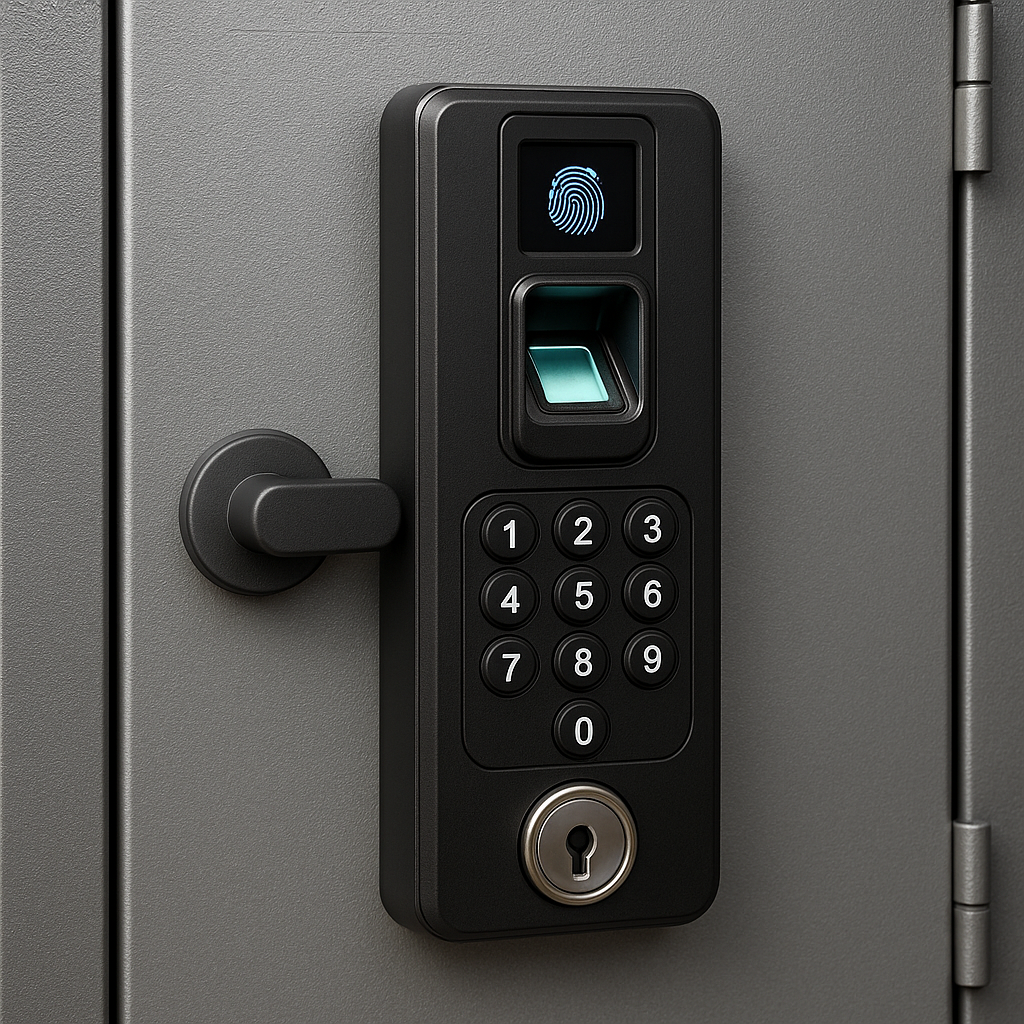أمن الخزائن الفولاذية: خيارات القفل البيومتري للاستخدام الحكومي
في المنشآت الحكومية، يُعدّ تأمين الوثائق والمعدات والأصول الحساسة أمرًا بالغ الأهمية. تُعدّ الخزائن الفولاذية، المعروفة بمتانتها ومقاومتها للهجمات المادية، عنصرًا أساسيًا في المكاتب الحكومية والقواعد العسكرية وغيرها من البيئات شديدة الحراسة. ومع ذلك، لا يعتمد أمان هذه الخزائن على متانتها فحسب، بل يعتمد أيضًا على آليات القفل المستخدمة.
تُعد القفازات التقليدية التي تعتمد على المفاتيح أو الأقفال الرقمية مُعَدَّة للتَّبَدُّل المتزايد بأجهزة قفل بيومترية متطورة، والتي تُقدِّم أمانًا وراحةً وقابليةً للمراجعة أفضل. يستعرض هذا المقال دور أقفال البيومترية في تعزيز أمان الخزائن الفولاذية للاستخدام الحكومي، مع توضيح مزاياها وأنواعها وتطبيقاتها والاعتبارات المتعلقة بتنفيذها.
أهمية التخزين الآمن في البيئات الحكومية
تتعامل الهيئات الحكومية مع مجموعة واسعة من المواد الحساسة، بما في ذلك الوثائق السرية والسجلات القانونية والبيانات المالية والمواد الخاضعة للرقابة. يمكن أن يؤدي الوصول غير المصرح إليه هذه المواد إلى عواقب وخيمة، مثل تسرب البيانات أو اختراق الأمن الوطني أو انتهاكات قانونية. تُستخدم الخزائن الفولاذية على نطاق واسع في هذه البيئات نظرًا لقوتها ومقاومتها للحريق وقدرتها على تحمل محاولات العبث. ومع ذلك، فإن حتى أقوى خزانة لا تكون أكثر أمانًا من آلية قفلها.
تتميز الأقفال التقليدية، مثل الأنظمة القائمة على المفاتيح أو الأكواد الميكانيكية، بثغرات أمنية كبيرة. إذ يمكن فقدان المفاتيح أو سرقتها أو تكرارها، كما يمكن مشاركة أكواد الدمج أو نسيانها. تجعل هذه الضعف الأقفال التقليدية غير مناسبة للاستخدام في التطبيقات الحكومية عالية الأمان. أما الأقفال البيومترية، التي تعتمد على خصائص فيزيولوجية أو سلوكية فريدة، فهي تعالج هذه المشكلات من خلال توفير مستوى أعلى من الأمان والمساءلة، مما يجعلها الاختيار الأمثل للاستخدام الحكومي.
ما هي الأقفال البيومترية؟
تستخدم القفالات البيومترية تقنية متقدمة لتوثيق هوية المستخدمين استنادًا إلى خصائص بيولوجية فريدة، مثل بصمات الأصابع، أو ملامح الوجه، أو أنماط القزحية، أو الصوت. وعلى عكس القفالات التقليدية التي تعتمد على المفاتيح المادية أو الأكواد التي يجب تذكّرها، تضمن الأنظمة البيومترية أن الأفراد المصرّح لهم فقط هم من يمكنهم الوصول إلى محتويات خزنة فولاذية. وتحوّل هذه القفالات البيانات البيومترية إلى قالب رقمي يتم تخزينه بأمان، ويتم مقارنته ببيانات إدخال المستخدم أثناء عملية التوثيق. وإذا تطابقت البيانات، تمنح القفالات الوصول.
تُعد القفالات البيومترية جذابة بشكل خاص في الاستخدامات الحكومية، لأنها تُلغي المخاطر المرتبطة بفقدان المفاتيح أو اختراق الأكواد. كما أنها توفر ميزات مثل سجلات التدقيق، التي تسجّل محاولات الوصول، وتوفر سجلًا يُظهر من قام بالوصول إلى الخزنة ومتى تم ذلك. وتُعد هذه степень من المساءلة أمرًا بالغ الأهمية في البيئات الحكومية، حيث تكون إمكانية التتبع غالبًا متطلبًا قانونيًا أو تنظيميًا.
فوائد القفالات البيومترية للخزائن الفولاذية الحكومية
أمان معزز
توفر القفالات البيومترية مستوى من الأمان لا تستطيع القفالات التقليدية منافسته. وبما أن الخصائص البيومترية مثل بصمات الأصابع أو أنماط القزحية فريدة لكل فرد، فهي extremely يصعب تقليدها أو تزويرها. علاوة على ذلك، تقلل الأنظمة البيومترية المتطورة، مثل تلك التي تستخدم كشف الأصابع الحية أو التعرف على الوجه ثلاثي الأبعاد، من خطر الوصول غير المصرح به من خلال التمييز بين المدخلات الحية والمدخلات الاصطناعية. وضماناً للوكالات الحكومية، تبقى المواد الحساسة محمية ضد التهديدات الخارجية والاستخدام غير المصرح به من الداخل.
الراحة والكفاءة
تُلغي القفالات البيومترية الحاجة إلى المفاتيح المادية أو الأكواد المعقدة، مما يسهل عملية الوصول للمستخدمين المصرح لهم. يمكن للمستخدمين فتح الخزائن بمسح سريع لبصمة أصابعهم أو وجوههم، مما يقلل الوقت الذي يُقضى في البحث عن المفاتيح أو تذكر التركيبات. وهذا مفيد بشكل خاص في بيئات العمل الحكومية السريعة، مثل العمليات العسكرية أو وحدات الاستجابة للطوارئ، حيث يكون الوصول السريع إلى التخزين الآمن أمراً بالغ الأهمية.
trails ومحاسبة
تأتي العديد من القفل البيومترية مزودة بقدرات تتبع العمليات، حيث تسجل التاريخ والوقت وهوية كل مستخدم يصل إلى الخزانة. هذه الميزة لا تقدر بثمن للوكالات الحكومية، حيث يتطلب الأمر رقابة صارمة والامتثال للوائح مثل قانون إدارة الأمن المعلوماتي الفيدرالي (FISMA) أو قانون قابلية نقل تأمين الرعاية الصحية ومحاسبة (HIPAA). تساعد تتبع العمليات على تتبع الوصول والتحقيق في الحوادث وضمان المحاسبة.
انخفاض خطر مشاكل إدارة المفاتيح
تتطلب الأنظمة القائمة على المفاتيح إدارة دقيقة لمنع فقدانها أو سرقتها أو نسخها غير المصرح به. تلغي القفل البيومترية هذه المخاوف من خلال استخدام السمات الفريدة لكل فرد كـ"مفتاح". ويقلل هذا من العبء الإداري وخطر حدوث خروقات أمنية ناتجة عن فقدان المفاتيح أو سرقتها.
المصادقة متعددة العوامل (MFA)
تُعد العديد من القفل الحيوية دعماً للمصادقة متعددة العوامل، حيث تجمع بين المصادقة الحيوية وطرق أخرى مثل أكواد الدخول أو بطاقات RFID. يُعزز هذا النهج المتعدد الأمن من خلال الحاجة إلى عدة أشكال من التحقق، مما يجعله مثالياً للتطبيقات الحكومية ذات الأمان العالي.

أنواع القفل الحيوية للخزائن الفولاذية
أقفال بصمة الإصبع
تُعد قفل البصمات النوع الأكثر شيوعاً من القفل الحيوية للخزائن الفولاذية. وتستخدم هذه القفل ماسحاً ضوئياً لالتقاط الحواف والنماذج الفريدة لبصمة المستخدم، والتي تُقارن بعد ذلك مع قالب مخزن مسبقاً. تتميز قفل البصمات بدقة عالية وسهولة الاستخدام وتكاليف معقولة، مما يجعلها مناسبة لمجموعة واسعة من الاستخدامات الحكومية، من الخزائن المكتبية إلى التخزين الآمن للأسلحة أو الموارد الطبية. كما يمكنها تخزين عدة بصمات (غالباً ما يصل إلى 20-100 بصمة)، مما يسمح بوصول عدة مستخدمين مُصرّح لهم.
قفل التعرف على الوجه
تستخدم أقفال التعرف على الوجه خوارزميات متقدمة لتحليل ميزات الوجه، مثل المسافة بين العينين أو شكل خط الفك. تعتبر هذه الأقفال بدون تلامس، وصحية، ومناسبة للبيئات التي قد يحتاج المستخدمون فيها إلى تجنب لمس الأسطح، مثل المرافق الطبية أو غرف النظافة. ومع ذلك، يمكن أن تتأثر أقفال التعرف على الوجه بظروف الإضاءة وقد تتطلب معدات أكثر تعقيدًا، مما يزيد التكلفة.
أقفال التعرف على القزحية
تقوم أقفال التعرف على القزحية بمسح الأنماط الفريدة في قزحية المستخدم، مما توفر واحدة من أكثر خيارات التعرف الحيوي أمانًا. يجعل هيكل القزحية المعقد من شبه المستحيل تزويرها، مما يجعل هذه الأقفال مثالية للتطبيقات الحكومية ذات الأمان العالي، مثل تخزين الوثائق السرية أو المعدات الحساسة. ومع ذلك، تكون ماسحات القزحية أكثر تكلفة وقد تتطلب تركيبًا متخصصًا.
أقفال التعرف على الصوت
تقوم قفل التعرف على الصوت بتحليل أنماط الصوت من أجل منح الوصول. وعلى الرغم من أنها مريحة للعمل بدون استخدام اليدين، إلا أنها أقل أمانًا من الطرق الحيوية الأخرى بسبب احتمال تقليد الصوت أو تسجيله. ونتيجة لذلك، تُستخدم التعرف على الصوت عادةً بال combination مع طرق مصادقة أخرى، كما أنها أقل شيوعًا في تطبيقات الخزائن الفولاذية في المؤسسات الحكومية.
الميزات الرئيسية التي يجب مراعاتها للاستخدام الحكومي
عند اختيار أقفال حيوية لخزائن الفولاذ في المنشآت الحكومية، يجب تقييم عدة ميزات لضمان توافقها مع الاحتياجات الخاصة للبيئة:
المتانة وتوافق المواد
تتعرض خزائن الفولاذ الحكومية في كثير من الأحيان للاستخدام المكثف ويجب أن تكون قادرة على تحمل الهجمات الجسدية. يجب أن تكون الأقفال الحيوية مصنوعة من مواد متينة، مثل سبيكة الزنك أو الفولاذ المقاوم للصدأ، لتتناسب مع متانة الخزانة. تعتبر الأقفال المعتمدة لتحمل قوة سحب كبيرة (على سبيل المثال، 569–598 رطلاً) مثالية للتطبيقات عالية الأمان.
إمدادات الطاقة والوصول في حالات الطوارئ
تعمل معظم القفل الكهربائية بالبطاريات، والتي تدوم عادةً حتى عام. ومع ذلك، تتطلب المنشآت الحكومية وسيلة موثوقة للوصول حتى أثناء انقطاع التيار الكهربائي. توفر القفل التي تحتوي على خيارات طاقة طوارئ، مثل منافذ USB أو آليات إلغاء قفل ميكانيكية، ضماناً بأن تظل الخزائن في متناول اليد في حال نفاد البطاريات. بعض القفل تُفتح تلقائياً عندما تنخفض مستويات البطارية إلى حد حرج، على الرغم من أن هذه الميزة يمكن تعطيلها لزيادة الأمان.
القدرة على استخدام عدة مستخدمين
غالباً ما تتطلب بيئات العمل الحكومية أن يكون لدى عدة مستخدمين مخولين الوصول إلى خزانة واحدة. يجب أن تدعم القفل البيومترية عدداً كافياً من ملفات المستخدمين (مثلاً، 20–200 بصمة) لاستيعاب الموظفين والمتعاقدين أو غيرهم من الأفراد.
التكامل مع نظم الأمن
يمكن أن تتضمن القفل الحيوية المتقدمة أنظمة أمان أوسع، مثل منصات التحكم في الوصول أو التطبيقات المحمولة. يسمح ذلك للمديرين بمراقبة سجلات الدخول، وتلقي إشعارات فورية، وإدارة أذونات المستخدمين عن بُعد. بالنسبة للوكالات الحكومية، يعزز التكامل مع الأنظمة الموجودة مثل Z-Wave أو المحطات المدعومة عبر Wi-Fi الكفاءة التشغيلية.
الامتثال للوائح
يجب أن تمتثل القفل الحيوية للوائح الحكومية فيما يتعلق بخصوصية البيانات والأمان، مثل اللائحة العامة لحماية البيانات (GDPR) للعمليات الدولية أو FISMA بالنسبة للوكالات الاتحادية الأمريكية. يجب أن تقوم القفل بتشفير البيانات الحيوية لحماية خصوصية المستخدمين والامتثال للمعايير القانونية.
سهولة التركيب
يجب أن تكون القفل الحيوية سهلة التركيب على الخزائن الفولاذية دون الحاجة إلى تعديلات واسعة النطاق. صُمّمت العديد من القفل لتكون قابلة للتركيب الذاتي، باستخدام أدوات قياسية وقطع تثبيت، وهو حل اقتصادي للنشر على نطاق واسع في المرافق الحكومية.
التطبيقات في البيئات الحكومية
تُعتبر القفالات البيومترية متعددة الاستخدامات ويمكن استخدامها في سياقات حكومية متنوعة، بما في ذلك:
تخزين الوثائق السرية : في المكاتب الفيدرالية أو القواعد العسكرية، تؤمن القفالات البيومترية الخزائن التي تحتوي على وثائق حساسة أو سرية، مما يضمن السماح فقط للأفراد المصرح لهم بالوصول إليها.
تخزين الأسلحة والذخيرة : تستخدم الوكالات العسكرية ووكالات إنفاذ القانون القفالات البيومترية لتأمين الخزائن الفولاذية التي تحتوي على أسلحة نارية أو ذخيرة أو معدات تكتيكية، ومنع الوصول غير المصرح به.
تخزين الأدوية والمعدات الطبية : في المرافق الصحية الحكومية، تحافظ القفالات البيومترية على الخزائن التي تخزن المواد الخاضعة للرقابة والسجلات الطبية أو المعدات الحساسة، مما يضمن الامتثال لقوانين HIPAA.
السجلات المالية والقانونية : تؤمن القفالات البيومترية الخزائن في الإدارات الحكومية المالية أو القانونية، وتحمي البيانات الحساسة من التلاعب أو السرقة.
مراكز البيانات والتخزين التقني : في المرافق التي تحتوي على معدات تقنية أو خوادم، تمنع القفل البيومترية الوصول غير المصرح إليه إلى البنية التحتية الحرجة.
خاتمة
تمثل القفل البيومترية تطوراً مهماً في تأمين الخزائن الفولاذية للاستخدام الحكومي. قدرتها على توفير أمان مُعزز وراحة وتحقيق الحسابات يجعلها الاختيار الأمثل لحماية المواد الحساسة في البيئات ذات المخاطر العالية. من خلال اختيار القفل بعناية مع ميزات قوية، مثل دعم المستخدمين المتعددين وسجلات التدقيق والبناء المتين، يمكن للوكالات الحكومية ضمان سلامة أصولها مع تسهيل الوصول للموظفين المصرح لهم.
مع استمرار تطور التكنولوجيا البيومترية، فإن دمجها مع إنترنت الأشياء والذكاء الاصطناعي سيُعزز من قدراتها بشكل أكبر، مما يجعلها ركيزة في البنية التحتية للأمن الحكومي. من خلال اعتماد القفل البيومترية، يمكن للمنشآت الحكومية أن تتخطى التهديدات الناشئة وتُحافظ على أعلى معايير الأمان.

 EN
EN






































